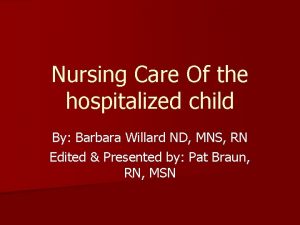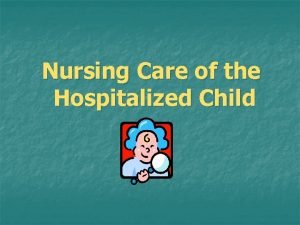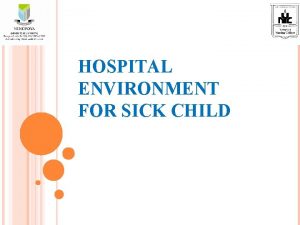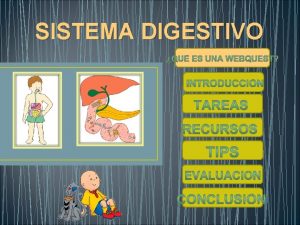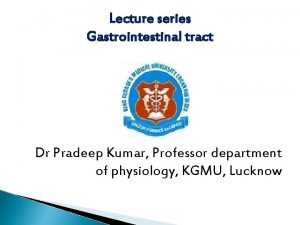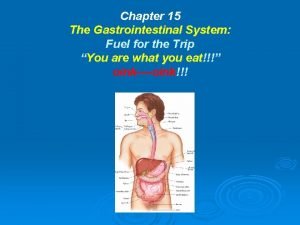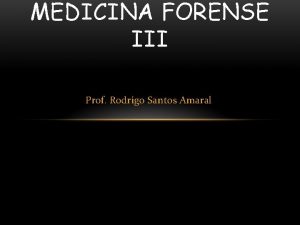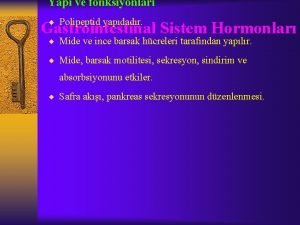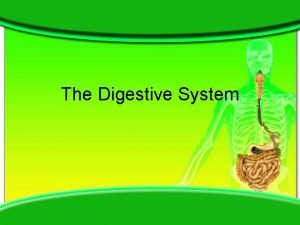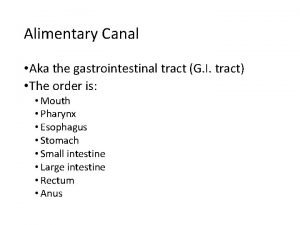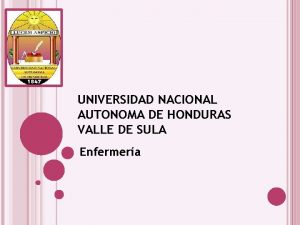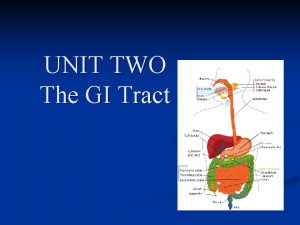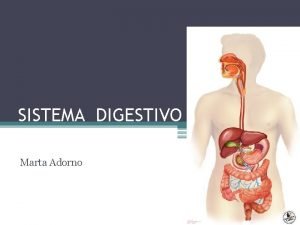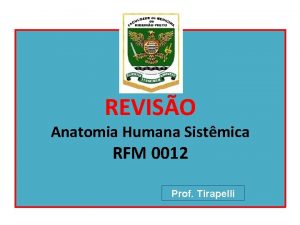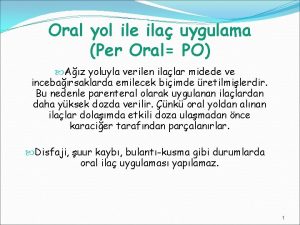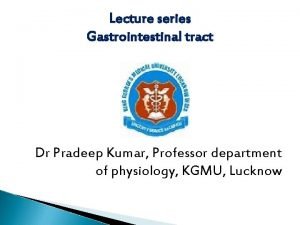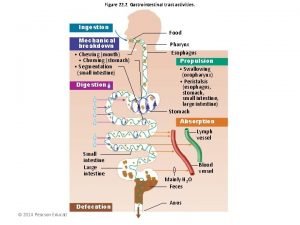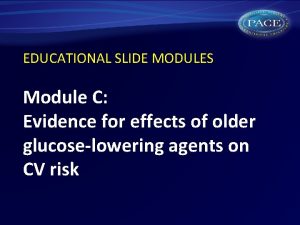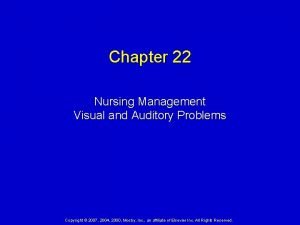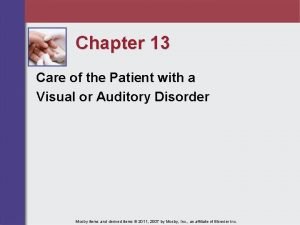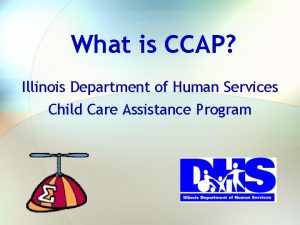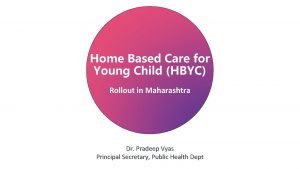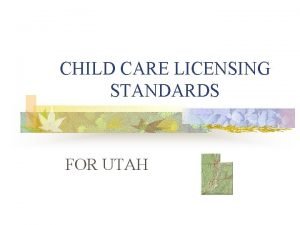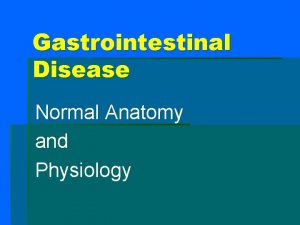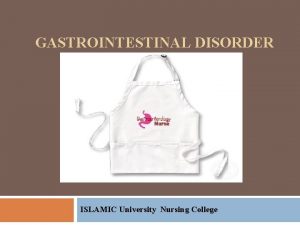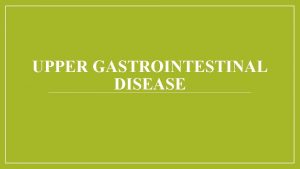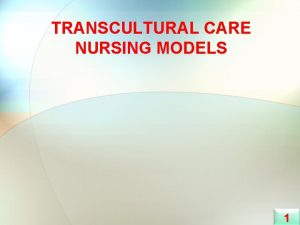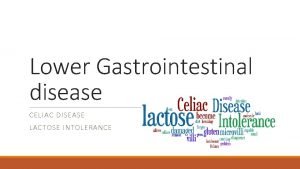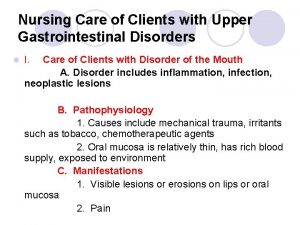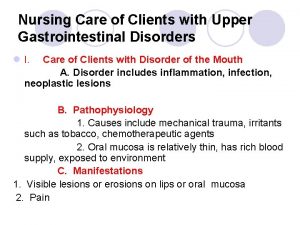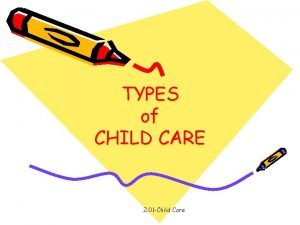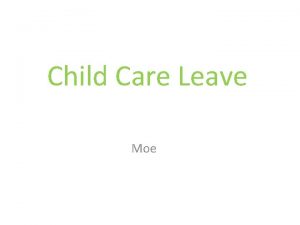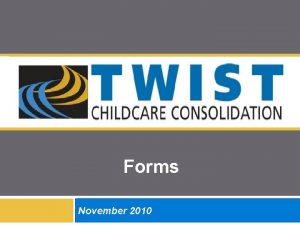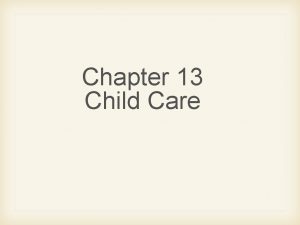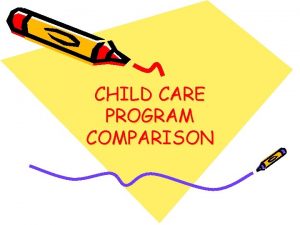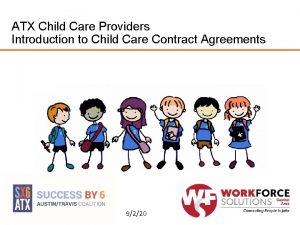NURSING CARE OF THE CHILD OF GASTROINTESTINAL DISEASE












































- Slides: 44

NURSING CARE OF THE CHILD OF GASTROINTESTINAL DISEASE Dr. Muntanavadee Maytapattana

TOPICS Overview GI System GI Disease �Diarrhea/ Gastroenteritis/ Gastritis �Intussusception/ Hirschsprung’s disease/ Cleft lip & Cleft palate/ TE fistula/ Imperforated anus Pain Assessment Nursing Care of GI Disease


INFECTIOUS GI DISEASE

DIARRHEA Frequency - Diarrhea can usually be defined as an increase in stool frequency to twice the usual number per day in infants, or three or more loose or watery stools per day in older children Consistency and color Duration -Acute diarrhea (< 7 days) -Persistent diarrhea (> 14 days) -Chronic diarrhea (> 21 days)

GASTROENTERITIS (INFECTIOUS DIARRHEA) Gastroenteritis is defined as vomiting or diarrhea due to infection of the small or large bowel The changes in the small bowel are typically non inflammatory, while the ones in the large bowel are inflammatory

Diarrhea & Vomiting Fever, fatigue, headache, and muscle pain If the stool is bloody, more likely to be bacterial Some bacterial infections may be associated with severe abdominal pain and may persist for several weeks

DIARRHEA &GASTROENTERITIS CAUSES Virus Bacteria (most common) Rota Virus E. Coli Parasite Shigella / Salmonella Entameba histolytica Strongyloides stercolalis Vibrio cholera Giardia lamblia

DIAGNOSIS Stool exam Stool culture Dehydration evaluation Electrolyte balance evaluation -Sodium imbalance -Potassium imbalance -Chloride imbalance -Acidosis / alkalosis

ASSESSMENT ปรมาณสารนำทควรไดรบตอวน Demand fluid (Maintenance fluid) *Holiday-Segar Formula* - 1 st 10 kg. = 100 ml. /kg. /day -2 nd 10 kg. = 50 ml. /kg. /day - Remained weight = 20 -30 ml. /kg. /day Fluid Deficit )สารนำทพรองหรอสญเสยไปแลวประเมนจากภา วะขาดนำ ( Concurrent loss M+D+C



GASTRITIS Gastritis is an inflammation, irritation, or erosion of the lining of the stomach. It can occur suddenly (acute) or gradually (chronic)


ASSESSMENT Gastritis is a condition marked by inflammation and irritation of the lining of the stomach Child with the condition may develop nausea, vomiting, appetite loss, and unexplained weight loss. Often, children will also feel full even though they haven’t eaten very much, become bloated, or belch frequently when they have Gastritis.


GI DESEASE WITH SURGERY

INTUSSUSCEPTION

Anatomy of the digestive tract showing the relationship of the small bowel to the stomach and colon Anatomy of a typical intussusception of ileum into the colon


INTUSSUSCEPTION Intussusception is a rare medical condition where one part of the small intestine draws back, into another part of the intestine Intussuception is a serious emergency that requires immediate treatment Nerves and tissue are dragged. The veins are compressed, which causes the area to swell and reduce its blood supply. If left untreated, a blockage in the intestine can cause that part of the intestine to develop gangrene and die It may also rupture, which will lead to abdominal infection and shock Boy: Girl; 3: 2, age < 2 years

ASSESSMENT The main symptom of intussusceptions is intermittent cramping or abdominal pain. Infants will cry as if in sharp pain, and may draw their knees up the chest at intervals with the pain. Yellow and green vomit not associated with eating is another sign. If the patient also has currant jelly stool, or stool mixed with blood and mucus, this can be a sign that some portions of intestine are already dead

DIAGNOSIS Doctor will then perform a thorough abdominal examination Be able to feel the actual intussusception as a sausage-shaped mass in the abdomen X-rays are sometimes done to view the obstruction for a second confirmation


TREATMENT Supportive treatment Barium reduction & Pneumatic reduction Operation �Surgical manipulation �Surgical resection with end-to end anastomosis


HIRSCHSPRUNG’S DISEASE (CONGENITAL MEGACOLON)

Normal Hirschsprung’s Disease


HIRSCHSPRUNG’S DISEASE An intestinal blockage due to impaired muscle movement within the bowel. Due to missing nerves within the bowel, intestinal contents accumulate, causing abdominal distention and bowel dysfunction. Often diagnosed in infancy, this condition causes newborns to develop constipation, abdominal distention, and vomiting. Additional symptoms may include the absence of a first stool (maconium), jaundice, and watery diarrhea Boy: Girl; 4 : 1

ASSESSMENT The presence of colon dilation In the presence of abdominal distention, Physical examination and palpation of the affected area may be performed. Any abnormalities discovered during a preliminary examination will usually prompt additional testing. If toxic megacolon is suspected, Abdominal X-ray and blood tests to evaluate electrolyte levels and detect the presence of any markers indicative of infection.


TREATMENT Supportive treatment -Rectal Irrigation Operation -Opened colostomy - Swenson, Duhamel, & Soave operation - Closed colostomy - Transanal endorectal pull through operation (dilate rectum 6 mo)

PAIN ASSESSMENT Neonatal Infant pain scale (NIPS) use for infant (0 -1 year old) The Children’s Hospital of Eastern Ontario Pain Scales (CHEOPS) use for children (>1 – 6 years old) Face Legs Activity Crying Consolidation (FLACC) use for children (>1 – 6 years old) Facial Expression Scales (FES) หรอ FACES use for children (>7 years old) Numerical Rating Scale (NRS) use for children (>7 years old) Behavioral Pain Scales (BPS) use for unconscious patient

CUT-OFF POINT Age 0 -1 y >1 -6 y Pain scale NIPS CHEOPS FLACC >7 y FES (FACES) NRS Unconscious BPS Range 0 -7 4 - 13 0 - 10 0 -10/ 0 - 5 0 - 10 3 - 12 Cut-off point 4 6 3 4/ 2 4 7

NURSING INTERVENTION &EVALUATION

NURSING DIAGNOSIS 1. Risk for intestinal perforation r/t distention of the intestinal 2. Risk for dysfunctional gastrointestinal motility r/t gastrointestinal perforate or peritonitis 3. Risk for intestinal inflammation r/t obstruction of the intestinal and decrease resistance of the intestinal wall 4. Risk for infection r/t upper and lower airway aspiration (Cleft lip & Cleft palate) 5. Diarrhea r/t gastrointestinal infection 6. Acute pain r/t increased peristalsis causing cramping 7. Deficient fluid volume and nutrition r/t excessive loss of fluids in liquid stools

NURSING DIAGNOSIS 8. Constipation: bowel obstruction r/t inhibited peristalsis as a result of congenital absence of parasympathetic ganglion cells in distal colon (Hirschsprung’s Disease) 9. Risk for retention of gas and gastric juice in stomach and intestinal r/t abnormal intestinal function 10. Impaired skin integrity r/t diarrhea 11. Parental anxiety r/t lack of exposure to information for treatment, surgical, and home care 12. Parental anxiety r/t congenital disease in newborn 13. Parental deficient knowledge r/t lack of disease and caring knowledge

NURSING DIAGNOSIS (POST -OPERATION) 1. Risk for decrease cardiac output r/t decrease fluid volume, blood volume, and electrolyte according to surgical procedure 2. Risk for separate, bleeding, and infection of the cleft lip and cleft palate surgical wound 3. Acute pain r/t surgical correction 4. Risk for skin infection or impaired skin integrity r/t irritation from bowel contents (on colostomy) 5. Disturbed body image r/t presence of stoma, daily care of fecal material (on colostomy)


Answer & Question



 Hirschsprung disease nursing management
Hirschsprung disease nursing management Ashraf radwan
Ashraf radwan Pathophysiology of intestinal obstruction
Pathophysiology of intestinal obstruction Nursing care of hospitalized child
Nursing care of hospitalized child Nursing care of hospitalized child
Nursing care of hospitalized child Hospital environment for a sick child
Hospital environment for a sick child Care plan on ocd
Care plan on ocd Cataract surgery nursing care
Cataract surgery nursing care Primary secondary tertiary health care
Primary secondary tertiary health care Embriologia del sistema gastrointestinal
Embriologia del sistema gastrointestinal Gastrointestinal tract
Gastrointestinal tract Gastrointestinal tract
Gastrointestinal tract Emt chapter 18 gastrointestinal and urologic emergencies
Emt chapter 18 gastrointestinal and urologic emergencies Chapter 15 the gastrointestinal system
Chapter 15 the gastrointestinal system Gastrointestinal hormones
Gastrointestinal hormones Malrotasi traktus gastrointestinal
Malrotasi traktus gastrointestinal Sinal de lichtenberg medicina legal
Sinal de lichtenberg medicina legal Sefalik faz
Sefalik faz Gastrointestinal medical terminology breakdown
Gastrointestinal medical terminology breakdown Focused physical assessment
Focused physical assessment Embryology
Embryology Gastrointestinal tract
Gastrointestinal tract Motilidad gastrointestinal
Motilidad gastrointestinal Dumping syndrome signs
Dumping syndrome signs Canal marta adorno
Canal marta adorno Anatomia rim
Anatomia rim Peroral ne demek
Peroral ne demek Intestinal villus
Intestinal villus Gastrointestinal
Gastrointestinal Metformin and constipation
Metformin and constipation Digestive system
Digestive system Communicable disease and non communicable disease
Communicable disease and non communicable disease 승자트리
승자트리 Nursing diagnosis for vision impairment
Nursing diagnosis for vision impairment Nursing diagnosis for meniere's disease
Nursing diagnosis for meniere's disease Hirschsprung disease nursing management
Hirschsprung disease nursing management Nursing intervention for parkinson's disease
Nursing intervention for parkinson's disease Nursing management of chronic liver disease
Nursing management of chronic liver disease Introduction modern concept of child care
Introduction modern concept of child care Introduction modern concept of child care
Introduction modern concept of child care Definition of pediatric nursing
Definition of pediatric nursing Child health nursing gnm 2nd year question paper
Child health nursing gnm 2nd year question paper Illinois child care eligibility calculator
Illinois child care eligibility calculator Hbyc ecd kit
Hbyc ecd kit Child care licensing utah
Child care licensing utah



